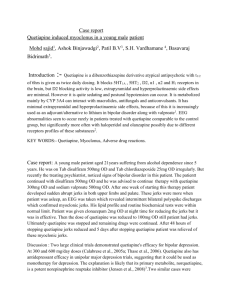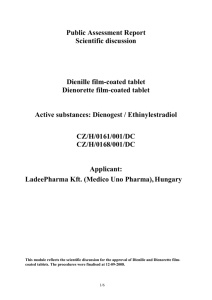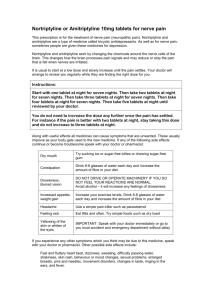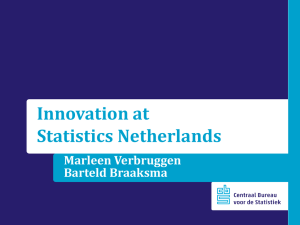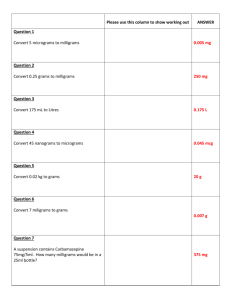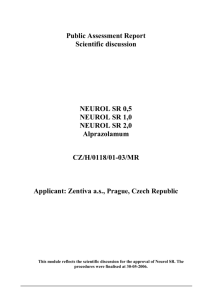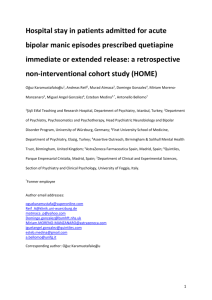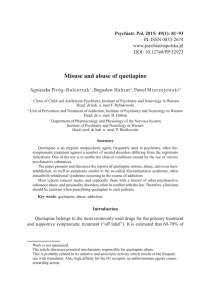Mutual Recognition Procedure
advertisement
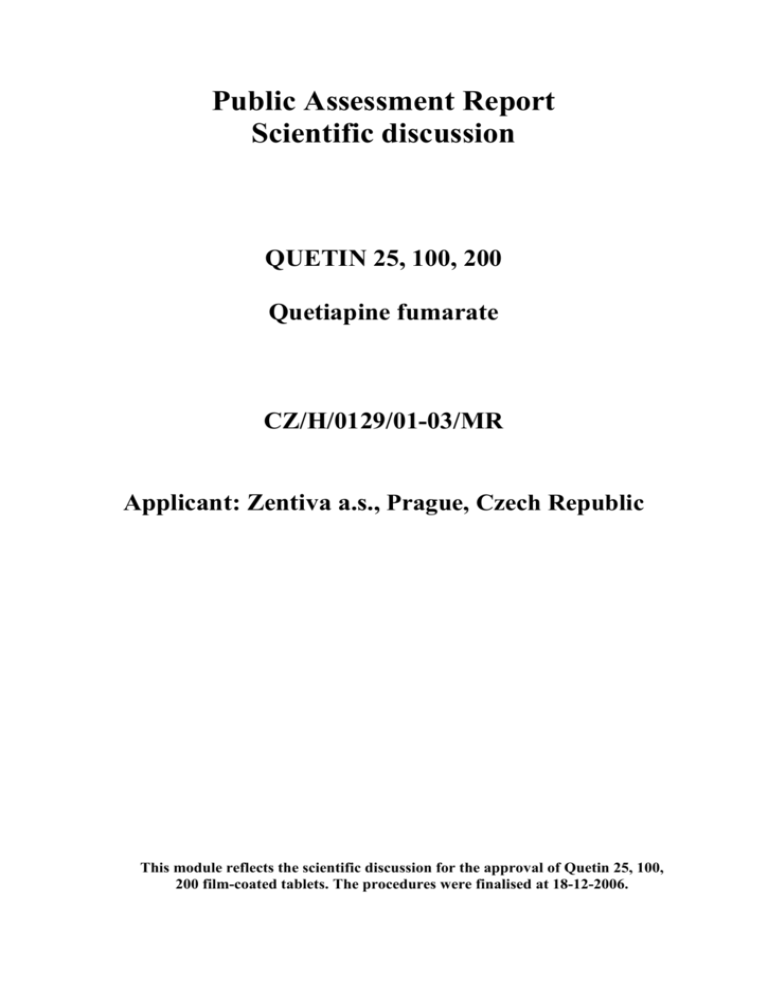
Public Assessment Report Scientific discussion QUETIN 25, 100, 200 Quetiapine fumarate CZ/H/0129/01-03/MR Applicant: Zentiva a.s., Prague, Czech Republic This module reflects the scientific discussion for the approval of Quetin 25, 100, 200 film-coated tablets. The procedures were finalised at 18-12-2006. QUALITY ASPECTS Introduction Quetin 25, 100, 200 is presented in the form of film-coated tablets containing 25 mg or 100 mg or 200 mg of quetiapine fumarate as the active substance. The excipients are microcrystalline cellulose, povidone 25, magnesium stearate, colloidal silicon dioxide, crospovidone and Sepifilm 5009 Pink in 25 mg tablets and Sepifilm 3048 Yellow and Sepifim 3084 Orange in 100 mg tablets and Sepifilm White 752 in 200 mg tablets as film-coated agent. Sepifilm 5009 Pink contains hydroxypropyl methylcellulose, microcrystalline celulose, polyoxyl 40 stearate, titanium dioxide and red iron oxide. Sepifilm 3048 Yellow contains hydroxypropyl methylcellulose, microcrystalline celulose, polyoxyl 40 stearate, titanium dioxide and quinoline yellow ws aluminium lake. Sepifilm 3084 Orange contains hydroxypropyl methylcellulose, microcrystalline celulose, polyoxyl 40 stearate, titanium dioxide, indigocarmine aluminium lake and iron oxide yellow. Sepifilm White 752 contains hydroxypropyl methylcellulose, microcrystalline celulose, polyoxyl 40 stearate and titanium dioxide. The tablets are packed in a white opaque PVC/PVDC/Al blister. The materials comply with the Ph.Eur. and with EU directives. Blisters are placed, together with a package leaflet, into a paper folding box. Active Substance The active substance is not described in any Pharmacopoiea. It is a white to yellowish crystalline substance, it is freely soluble in methanol and ethanol, slightly soluble in water. It shows polymorphism. The molecule of quetiapine fumarate has no chiral centres. The scientific information has been submitted in form of an Active Substance Master File from both of the manufactures. The Letters of Access from the manufacturers were provided. The manufacture has been described in detail. Both manufacturers produce the same crystaline form. An appropriate in-house specification for quetiapine fumarate has been proposed. Certificates of analysis have been provided. Results comply with the proposed specification and confirm the consistency of the process. Appropriate stability studies according to ICH guidelines have been carried out. Results showed no significant change and remained within the specification. Therefore the proposed re-test period of 2 years is justified based on the stability results when substance is kept in the proposed packaging (double PE bags). No special storage condition is required. Medicinal Product The qualitative and quantitative composition of Quetin 25, 100 and 200, film-coated tablets is detailed including composition of film-coating agents. Most of excipients are commonly used in the pharmaceutical industry and are described in the Ph.Eur. The coating agents correspond to the in-house specification, this is acceptable. Pharmaceutical Development The aim was to develop a stable immediate release tablets that are comparable with the reference product Seroquel. The essential similarity, based on comparison of dissolution profiles, impurity profiles and bioequivalence, with Seroquel has been documented. Satisfactory Certificates of Analysis of all excipients have been provided. Magnesium stearate is of vegetal origin. A statement from the supplier confirms the Sepifilms excipients are of vegetable or synthetic origin. Manufacturing of the product The manufacturing process can be stated as standard. Satisfactory controls of the manufacturing process are described with specifications, which are considered adequate to assure the quality of the product The process was validated according to satisfactory validation plan. Product specification Satisfactory control tests are applied at time of release and during the shelf-life. Release and shelf life limits for the assay of quetiapine fumarate are in line with batch and stability data. Limits for related substances are in line with ICH guidelines and stability data. Analytical methods have been satisfactorily described and validated in accordance with regulatory requirements. Satisfactory batch analysis data have been provided for four batches of 25 mg tablets, three batches of 100 mg tablets and two batches of 200 mg tablets. Stability of the product Stability trials were performed on the drug product according to the stability protocols and ICH guidelines. The shelf-life of 24 months and storage condition “Do not store above 30°C” are in compliance with stability data and are acceptable. The applicant declares that the storage conditions will be revised after finishing stability studies of the first production batches. Discussion on chemical and pharmaceutical aspects Information on development, manufacture and control of the drug substance and drug product has been presented in a satisfactory manner. The results of tests carried out indicate satisfactory consistency and uniformity of important product quality characteristics, and these in turn lead to the conclusion that the product should have a satisfactory and uniform performance in the clinic. CLINICAL ASPECTS Based on the review of data on quality, safety and efficacy, the RMS considered that the application for Quetin, tablets, in the treatment of acute and chronic psychoses, including schizophrenia, and in the treatment of manic episodes accompanying bipolar disorders, could be approved. This is an abridged application. The applicant claims essential similarity, under article 10.1 (a)(iii) 1st par.of Directive 2001/83/EC, to Seroquel, tablets, AstraZeneca, Macclesfield, UK, authorised for more than 10 years in Europe. Seroquel has been authorised in the Czech Republic since 1999 (MANo 68/454-6/99-C, marketing authorisation holder AstraZeneca, Macclesfield, UK). Quetiapine is a serotonin, dopamine D1 and D2, histamine H1, and adrenergic α1 and α2 receptors in the brain. The drug is used in the treatment of schizophrenia and acute manic disorders associated with bipolar disease. Quetiapine improves both psychotic symptoms and cognitive functions in schizophrenia. Similarly to the other substances used in these indications, exact mechanism of action is unknown. However, it has been proposed that quetiapine therapeutic effects are mediated through a combined dopamine D2 and serotonin 5HT2 antagonism. Antagonism at other sites may be an explanation of side effects of the drug. No new preclinical studies and no clinical studies were conducted, which is acceptable given that the applications were based on essential similarity to a product that has been licensed for more than 10 years. The application contains an adequate review of published clinical data. To support the application, the applicant has submitted as report 2 bioequivalence studies: one single-dose bioequivalence study at fasted state has been conducted for 25 mg strength and one single-dose bioequivalence study at fasted state has been conducted for 100 mg strength. Because quetiapine shows linear and dose-proportional pharmacokinetics, the results obtained for the 25 mg tablet and 100mg tablet can be extrapolated to the 200 mg tablet. Essential similarity has been sufficiently proven by the bioequivalence studies that comply with current requirements and by comparison of dissolution and impurity profiles. Quality of the product Quetin tablets and GMP standards of manufacture have been sufficiently demonstrated. The SPC of product Quetin tablets corresponds to the SPC of reference product. RMS propose to change the SPC according the latest pharmacovigilance information (see below). The Package leaflet has been shown to provide the tested consumers with all required information in a clear and comprehensive form and the Readability testing was performed according to the guidelines. The Package leaflet for Quetin has been shown to provide the tested consumer with all required information in a clear and comprehensive form and the Readability testing was performed according to the guidelines. To support the application, the applicant has submitted as report 2 bioequivalence studies. Two studies were conducted to prove bio-equivalence of Quetin 25 and 100mg with the reference product Seroquel 25, and 100 mg tab. A two-way, randomized, single-dose, cross-over, fasted study of Quetin100mg in healthy subjects has been conducted. Thirty-two healthy Caucasians of both genders were enrolled into the study when fulfilling inclusion criteria, mainly physical examination, medical history, basic biochemistry, and hematology screens. Twenty-eight subjects completed the study and 26 were included in the PK evaluation. Mean age of the subjects was 26 years (range 18-46); mean weight 68.5 kg (range 51.2-86.6kg). Body frame was assessed using BMI scale. Subjects were required to refrain from any medication 14 day prior the study and were asked to abstain from alcohol and smoking for 48 hours, and from caffeine-containing food and beverages for 3 days prior the study session. Intake of CO2-containing beverages has been prohibited during each study periods. Subjects were randomly assigned with a sequence of administered products under balanced condition. Study medication was administered with 200ml of water. Fluid intake was restricted and subjects were fasting during 4 hours post-dose. After this time fluid intake was allowed ad libitum and meals were standardized during both study sessions. Study treatment consisted of 100mg quetiapine tablet administered on day 3 of each study period. Prior to the administration of 100mg dose, a dose titration with 3 single 25mg doses at 12 hour intervals has been performed due to the safety reasons. Four subjects dropped out between periods due to intercurrent illness, two subjects were excluded from analysis in accordance with the protocol in order to keep the group-sequence balanced. All the clinical and analytical procedures were inspected and statement of compliance with GCP and GLP is presented. Plasma concentration of quetiapine was determined by HPLC-MS/MS method in 19 sampling points up to 48 hours post-dose. Analytical method was validated with the limit of quantitation 1.0 ng/ml. Descriptive statistics was used to summarize the results. Two-way ANOVA was carried out on all AUCs, Cmax, and tmax values in which subject, treatment, sequence, and period were evaluated. Individual data are presented, logarithmic transformation used. The results fulfilled prespecified criteria for accepting bioequivalence between test and reference product. A two-way, randomized, single-dose, cross-over, fasted study of Quetin25mg in healthy subjects has been conducted. Thirty healthy Caucasians of both genders were enrolled into the study when fulfilling inclusion criteria, mainly physical examination, medical history, basic biochemistry, and hematology screens as specified in the protocol STUDY 13/04/QTP25/BSD. Twenty-nine subjects completed the study and 28 were included in the PK evaluation. Mean age of the subjects was 32 years (range 19-49); mean weight 71.4 kg (range 55.1-91.0kg). Body frame was assessed using BMI scale. Subjects were required to refrain from any medication 14 day prior the study and were asked to abstain from alcohol and smoking for 48 hours, and from caffeine-containing food and beverages for 3 days prior the study session. Intake of CO2-containing beverages has been prohibited during each study periods. Subjects were randomly assigned with a sequence of administered products under balanced condition. Study medication was administered with 200ml of water. Fluid intake was restricted and subjects were fasting during 4 hours post-dose. After this time fluid intake was allowed ad libitum and meals were standardized during both study sessions. Study treatment consisted of 25mg quetiapine tablet administered on day 1 of each study period. One subject dropped out prior to the period 1 due to personal reasons. This subject was subsequently replaced by a next qualifying alternate. One subject was withdrawn when completing period 1 due to an adverse event (syncope). Subject with the highest No. has been afterwards excluded from analysis in accordance with the protocol in order to keep the groupsequence balanced. All the clinical and analytical procedures were inspected and statement of compliance with GCP and GLP is presented. Plasma concentration of quetiapine was determined by HPLC-MS/MS method in 19 sampling points up to 32 hours post-dose. Analytical method was validated with the limit of quantitation 1.0 ng/ml. Descriptive statistics was used to summarize the results. Two-way ANOVA was carried out on all AUCs, Cmax, and tmax values in which subject, treatment, sequence, and period were evaluated. Individual data are presented, logarithmic transformation used. The results fulfilled prespecified criteria for accepting bioequivalence between test and reference product. Bioequivalence has been satisfactorily demonstrated.



